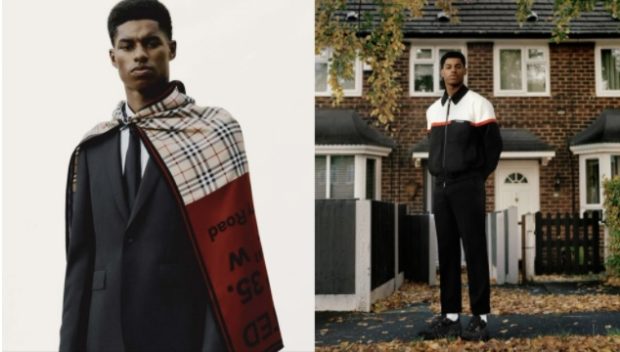You have no items in your cart. Want to get some nice things?
Go shopping
Image courtesy of Burberry.
Stony-faced, besuited, a long scarf draped over his shoulders like a superhero’s cape, the polished image of British footballer Marcus Rashford modelling for Burberry would look at home in any luxury fashion campaign from the past few years.
But the London label’s decision to employ Rashford, a Manchester United player now perhaps better known for his food poverty campaigning than his considerable sporting ability, is something fresh and special. Something that could only happen at this particular, pandemic-inflected cultural juncture.
Because thanks to Covid-19, cool ain’t what it used to be. Our fashion idols were once rebels with varying degrees of cause; from Elvis to Jimi Hendrix and Kate Moss to Lady Gaga, we were accustomed to subversive individuals setting the trends by holding their manicured middle fingers up to the staid status quo.
But that was before the status quo got quite so bad. Mainstream reality is now a hellscape in which 2.5 million people have died globally in a mismanaged pandemic, Texas has frozen over and kids even in the richest countries are routinely going hungry. To rebel against the norm is now by definition to advocate positive change through community and kindness.
Rashford’s appointment reflects this shift over the past year, as activism, charity and accessibility have come to redefine the style zeitgeist. Sustainability has come to the fore, with the resale market expected to be bigger than fast fashion within the next decade, Net-A-Porter is selling “Kindness Is Magic” beaded bracelets, and our fashion heroes look very different to a year ago.
British Vogue spurned supermodels for its July 2020 cover, instead featuring a train driver, a supermarket cashier and a midwife in recognition of the sacrifices of key workers. The current It bag is the Telfar tote, a sleek, practical shopper which retails for a tenth of the price of a Gucci piece and is frequently spotted on the arm of grassroots US politician Alexandria Ocasio-Cortez. And a streetwear-designing nurse from New York secured his breakthrough in 2020, and now uses his Covid-19 hospital experiences as inspiration for pieces.
Fashion’s rediscovering of its soul doesn’t mean the industry is losing its edge. In fact, it might be unearthing its roots. Cool has always been reactionary; “a resistant mode of being in the world” as writer and professor Joel Dinerstein puts it. The concept of American cool can be traced back to jazz culture, and Dinerstein credits African-Americans with inventing coolness in “stylistic defiance against racism during World War II”.
But in the decades since Billie Holiday, Humphrey Bogart and Muhammed Ali first modelled the countercultural mode of self-possession we would come to understand as “cool”, the concept was commoditised by corporate culture, eventually hollowed out to something sellable, filtered to the masses through style leaders like Kim Kardashian and Justin Bieber and available at bargain prices through fast fashion retailers.
No one can pretend that pre-pandemic life in the rich world was a bed of roses. We lived with climate change, structural inequalities and economic malaise. We had plenty to rebel against. But quite how bad things were, and which things needed to be fixed, was a point of debate, not a fact. Deepening culture wars meant we couldn’t coalesce around a single cause. Now Covid is our common enemy, and the counterculture is earnest resistance to its outcomes.
What’s cooler than being cool? Being kind.

About Clare Kane
Clare is a fashion writer and novelist based in London, and is particularly interested in the social, cultural and historical reasons behind why we wear what we wear. She is the author of Chinese historical fiction novels Dragons In Shallow Waters and Electric Shadows of Shanghai.




